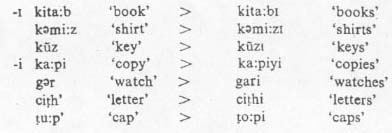
NOTE: Click on any image to listen to its audio clip.
Notes
In this lesson, we have
introduced simple declarative and interrogative sentences using demonstrative
pronouns, f.mp3s of the copular verb in the present tense and an interrogative
word  'what'. 'what'.
Demonstrative pronouns
Kashmiri has the following
three t.mp3 system of demonstrative pronouns in the nominative case:

These demonstrative pronouns can be used with both
animate and inanimate subjects. The third category of demonstrative pronouns has
not been used in this lesson. The t.mp3  can
also be used alternately with can
also be used alternately with  in case the subject is inanimate. The masculine plural f.mp3s
in case the subject is inanimate. The masculine plural f.mp3s  are used for honorific singular subjects as well.
are used for honorific singular subjects as well.
Word order
In Kashmiri, the verb usually comes
in the second position. The surface word order of a simple declarative sentence
is subject+verb+object. The word order of a question word interrogative sentence
is: subject+interrogative word+verb+remaining constituents.
Examples:

Copular verb
The copular verb agrees with the
subject in both number and gender. Following are f.mp3s of the copular verb in
present tense used with third person subject:

Gender
There are two genders in Kashmiri:
masculine and feminine. All the inanimate nouns (as well as animate ones) are
assigned to one of the two genders.
Number
There are two numbers:
singular and plural. There are different types of rules for plural formation
which apply according to the phonological structure of the words. Some of these
rules are indicated below:
(1) Most of the consonant ending with the vowel /I/
ending masculine nouns do not change in their plural f.mp3:

(2) The vowels  changes into
changes into  respectively
and the word final non-palatal consonants are palatalized: respectively
and the word final non-palatal consonants are palatalized:

(3) Palatal consonants do
not change in plural f.mp3s:

(4) The second vowel /u/
in disyllabic words changes to /a/ in plural f.mp3s:

(5) Most of the feminine
plurals are f.mp3ed by adding suffixes -I or -i depending on the phonological
structure of the word. After these suffixes are added, certain other changes may
take place:

(6) Besides certain
changes in vowels, the consonants  change into /ts/, /c/ and /j/ respectively in some cases:
change into /ts/, /c/ and /j/ respectively in some cases:

(7) In one case there is a
change of only vowel:

(8) The /i/ ending
feminine nouns do not change in their plural f.mp3s:

|